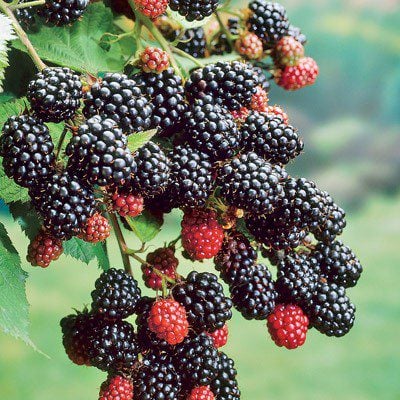
Learning Download: How to Grow Blackberries
From Seed to Harvest: A guide to growing blackberries.
Fruit plants are not grown from seed, but from transplants, roots or crowns. This can provide a bit more difficulty for the at-home gardener, but blackberries are one of the easiest fruits to grow. Blackberries can grow just about anywhere in the United States as long as they receive enough sun exposure.
To plant:
Blackberry plants are grown from a crown and roots and they are self-fertile, so multiple plants will not be needed to produce the fruit. When planting blackberries, if the cultivars are semi-erect, space plants 5 to 6 feet apart. If the cultivars are erect, space them 3 feet apart. For trailing varieties, space plants 5 to 8 feet apart. Plant the blackberries shallowly. Planting should be done in early spring so cold winter months don’t kill the transplants.
To grow:
Mulch the blackberry plants throughout the season to deter weeds and retain moisture. Spread a thick layer of mulch around the base of the plants. Blackberries like plenty of water, especially when the berries are ripening. Be sure the blackberry plants receive at least 1 inch of water per week. For trailing varieties, add a trellis or a type of support system for the vines. One of the best ways to provide a support system for blackberry plants is to add a two-wire system, with the top wire running 5 feet above the ground and the bottom wire running 18 inches below the top wire. Fruiting floricanes will be along the wires after the first year of growth. Train any new primocanes into a narrow row below the fruiting canes. It will be simpler to direct all canes into the same direction. Primocane growth is vegetative, but floricanes produce fruit. Floricanes will die back each year.
Blackberry plants must be pruned. After trailing varieties produce fruit, remove the floricanes to the ground, but wait to do so until they have already died back a decent amount. This will push more nutrients to the roots and crown of the plant. Primocanes don’t require pruning. For non-trailing varieties, once primicanes reach 4 feet, remove the top 4 inches. This will produce a bushier plant with more yields in the future.
To harvest:
Blackberries are ready to pick once they are fully black. Keep the central plug within the fruit when picking the berries, which is different when picking raspberries. Blackberries should be harvested during cooler parts of the day, and they will only last a few days after harvest.
What blackberries crave:
Fertilize blackberries in the early spring with an all-purpose, 10-10-10 or 16-16-8 fertilizer.
Where to buy blackberry plants:
You can find blackberry plants at Urban Farmer.
Learning Download: Common pests and diseases: Blackberries
Common pests and diseases: Blackberries
When growing fruits and vegetables, it is always exciting to care for the plant throughout its growing phase and then harvest it for delicious recipes later on, but one thing to watch out for is pests and diseases. Different plants are susceptible to different types of pests and diseases, and it is important to make yourself aware so you can keep a watchful eye and also take any preventative methods to keep your plants safe throughout their lifespan.
Blackberries can fall victim to several pests and diseases.
Pests:
Some of the most common pests affecting the blackberry plant are nematodes and the Japanese beetle.
Nematodes most often affect the root of the plant first, which means the symptoms are difficult to notice. The damage increases as the nematodes increase, and only the main root is left. The plant will have a decrease in growth and fruit production if there is a nematode infestation. To prevent this problem, only plant nematode-free plants and fumigate the ground prior to planting.
Japanese beetles cause problems to many plants. On blackberry plants, they affect the roots, leaves and fruit. The beetle’s larvae feed on the roots, and the adults feed on the leaves and fruits. Both larvae and adults cause damage. To prevent this problem, use insecticides.
Diseases:
Some of the most common diseases affecting blackberries include purple blotch, Botryosphaeria cane canker, downy milder, powdery milder and more.
Purple blotch affects the branches of the blackberry plant. It causes small green sores to appear on the branches closest to the ground. The disease spreads upwards as it gets worse, and the sore will appear red or brown. The best way to prevent this problem is to plant healthy plants which haven’t grown around wild blackberries.
Botryosphaeria cane canker also affects the branches, and it causes sores to appear on the buds near the main stems. They will be red/brown in color. These sores usually occur in an area that has been wounded, and the infection normally doesn’t kill the plant. The best prevention method is to plant blackberry bushes resistant to this disease, and also do not over fertilize with nitrogen.
Downy mildew affects the leaves, and it will cause yellow and then purple. Leaves may fall off early, and the fruit may appear dull. Try to reduce the amount of moisture the plants are exposed to, as this will help prevent the disease.
Powdery mildew affects the entire plant. The leaves will be infected first and then appear wet or soggy. Once it worsens, the disease may cause white fungus to grow on the fruit. To prevent this, cut the plant back in the spring and also plant disease-resistant varieties.

